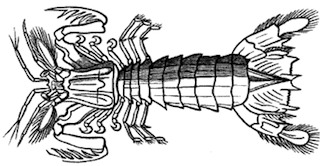
Lobster - a Crustacean
First, delving into more taxonomy, consider that Decapoda are an order of the Crustacea (itself a subphylum of the phylum Arthropoda which also encompasses Insecta) and hence they inherit aspects of the Crustacea and Arthropoda both. Here is where we get to learn about biramous appendages (more Latin reminiscences tell us that biramous means 'double branched'), because as well as a chitinous exoskeleton Crustacea characteristically have biramous (branched) appendages.
Other appendages of Crustacea are the two (not just one) pairs of antennae which are in front of the mouth, which itself is adorned with its own paired jaw-like appendages as well as multiple (three) pairs of biting appendages which further constitute the Crustacea mouth.
Through the miracle of evolution, Nature provided not just several pair of legs and mouthparts, but enough variety in how these body segments and appendages are arranged, sized relatively and shaped that one can be at times hard put to come an easy identification of what is an Crustacean or not.
Crustacea include not only lobsters and crayfish (similar enough and familiar enough), and crabs (still somewhat lobster like in many respects), but also barnacles (not very lobster-like in outward appearance), and shrimp, prawns, waterfleas, krill and copepods. Note: Waterfleas may look like fleas, but they are not closely related to fleas which are in fact an order of Insecta.
All Crustacea have nineteen body segments, which may or may not be fused together in vary degrees. These segments are grouped into two main body parts, the first part is the cephalothorax and the second part is the abdomen. Each of the individual body segments may have a pair of appendages, but at times these may be reduced in size, vestigial, or even missing altogether. Of these various pairs of appendages, in Crustacea there are usually eight pairs of thoracic appendages.

Locust Shrimp
Finally, as Arthropods, Crustacea have a hard exoskeleton. As they grow they molt (shed) this exoskeleton periodically to accommodate their growth within it.